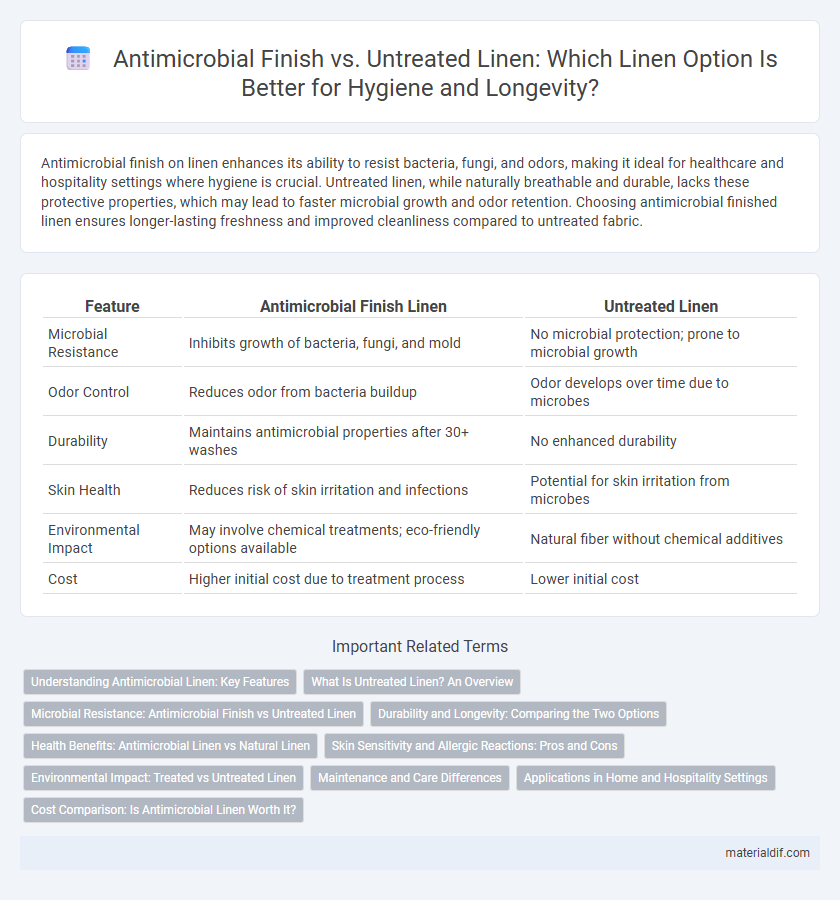Antimicrobial finish on linen enhances its ability to resist bacteria, fungi, and odors, making it ideal for healthcare and hospitality settings where hygiene is crucial. Untreated linen, while naturally breathable and durable, lacks these protective properties, which may lead to faster microbial growth and odor retention. Choosing antimicrobial finished linen ensures longer-lasting freshness and improved cleanliness compared to untreated fabric.
Table of Comparison
| Feature | Antimicrobial Finish Linen | Untreated Linen |
|---|---|---|
| Microbial Resistance | Inhibits growth of bacteria, fungi, and mold | No microbial protection; prone to microbial growth |
| Odor Control | Reduces odor from bacteria buildup | Odor develops over time due to microbes |
| Durability | Maintains antimicrobial properties after 30+ washes | No enhanced durability |
| Skin Health | Reduces risk of skin irritation and infections | Potential for skin irritation from microbes |
| Environmental Impact | May involve chemical treatments; eco-friendly options available | Natural fiber without chemical additives |
| Cost | Higher initial cost due to treatment process | Lower initial cost |
Understanding Antimicrobial Linen: Key Features
Antimicrobial linen incorporates specialized treatments that inhibit the growth of bacteria, fungi, and other microbes, enhancing hygiene and extending fabric lifespan compared to untreated linen. These finishes often utilize silver ions or natural biocides, which remain effective through multiple washes without compromising the linen's breathability and softness. Untreated linen, while breathable and hypoallergenic, lacks this microbial protection, making antimicrobial linen a superior choice for environments requiring enhanced cleanliness.
What Is Untreated Linen? An Overview
Untreated linen refers to flax fibers processed without chemical or antimicrobial treatments, preserving its natural properties such as breathability, durability, and hypoallergenic qualities. Unlike antimicrobial-finished linen, untreated linen does not inhibit bacterial growth, which can lead to faster odor development and potential fabric degradation. Choosing untreated linen prioritizes eco-friendly, chemical-free textiles but may require more frequent washing to maintain freshness and hygiene.
Microbial Resistance: Antimicrobial Finish vs Untreated Linen
Antimicrobial finished linen exhibits significantly higher microbial resistance compared to untreated linen, effectively inhibiting the growth of bacteria, fungi, and other pathogens. This finish reduces odor-causing microbes and enhances the fabric's hygiene, making it ideal for healthcare and hospitality settings. Untreated linen lacks these protective properties, making it more susceptible to microbial contamination and faster degradation.
Durability and Longevity: Comparing the Two Options
Antimicrobial finished linen demonstrates enhanced durability by resisting microbial damage, which preserves fabric integrity and extends lifespan compared to untreated linen. Untreated linen, while naturally breathable and strong, is more susceptible to bacteria and mold, leading to faster deterioration over time. Investing in antimicrobial treatment significantly improves linen's longevity, making it a practical choice for high-use or hygiene-sensitive applications.
Health Benefits: Antimicrobial Linen vs Natural Linen
Antimicrobial linen provides superior health benefits by inhibiting the growth of bacteria, fungi, and other pathogens compared to untreated natural linen. This enhanced protection reduces the risk of infections, allergens, and unpleasant odors, making antimicrobial linen ideal for sensitive skin and healthcare environments. While natural linen offers breathability and comfort, antimicrobial finishes ensure prolonged hygiene and safety in everyday use.
Skin Sensitivity and Allergic Reactions: Pros and Cons
Antimicrobial-finished linen reduces the growth of bacteria and fungi, lowering the risk of skin irritation and allergic reactions for sensitive skin, but some finishes may cause chemical sensitivities or contact dermatitis in certain individuals. Untreated linen offers natural breathability and hypoallergenic properties, making it suitable for sensitive skin, though it may harbor more microbes that could trigger allergies over time. Choosing between antimicrobial and untreated linen depends on individual skin tolerance and the specific chemical agents used in the antimicrobial treatment.
Environmental Impact: Treated vs Untreated Linen
Antimicrobial finish on linen typically employs chemical agents that may pose environmental concerns due to potential toxicity and reduced biodegradability, impacting ecosystems during production and disposal. Untreated linen relies on its natural properties, offering a more eco-friendly option with lower chemical use and enhanced biodegradability, minimizing environmental footprint. Selecting untreated linen supports sustainable textile practices by reducing reliance on synthetic antimicrobial compounds and preserving soil and water quality.
Maintenance and Care Differences
Antimicrobial finish on linen significantly reduces bacterial growth, minimizing odors and stains compared to untreated linen, which requires more frequent and intensive cleaning to maintain freshness. Treated linen often allows for gentler washing cycles and lower temperatures, extending fabric lifespan and reducing wear, while untreated linen needs harsher laundering to remove contaminants effectively. Care instructions for antimicrobial linen emphasize mild detergents and avoiding bleach to preserve the finish, unlike untreated linen, which can tolerate stronger chemicals without risking the loss of protective properties.
Applications in Home and Hospitality Settings
Antimicrobial finished linen offers enhanced protection against bacteria, mold, and odors, making it ideal for high-traffic home and hospitality environments such as hotels, hospitals, and restaurants. Untreated linen, while breathable and naturally durable, lacks this additional layer of hygiene, increasing the risk of microbial growth and unpleasant odors over time. Choosing antimicrobial linen improves sanitation standards, extends fabric lifespan, and elevates guest comfort in demanding settings.
Cost Comparison: Is Antimicrobial Linen Worth It?
Antimicrobial linen typically incurs higher upfront costs compared to untreated linen due to specialized chemical treatments and advanced manufacturing processes. While antimicrobial finishes reduce microbial growth, extend fabric lifespan, and enhance hygiene, these benefits must be weighed against increased purchase prices and potential environmental impact. For healthcare and hospitality industries prioritizing cleanliness, the investment often results in long-term savings by minimizing laundering frequency and contamination risks, making antimicrobial linen cost-effective.
Antimicrobial Finish vs Untreated Linen Infographic

 materialdif.com
materialdif.com